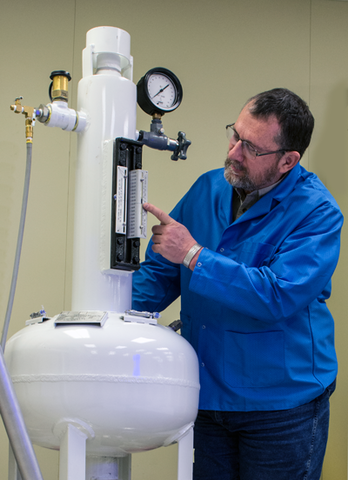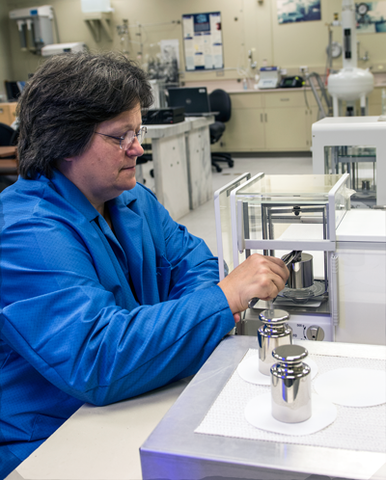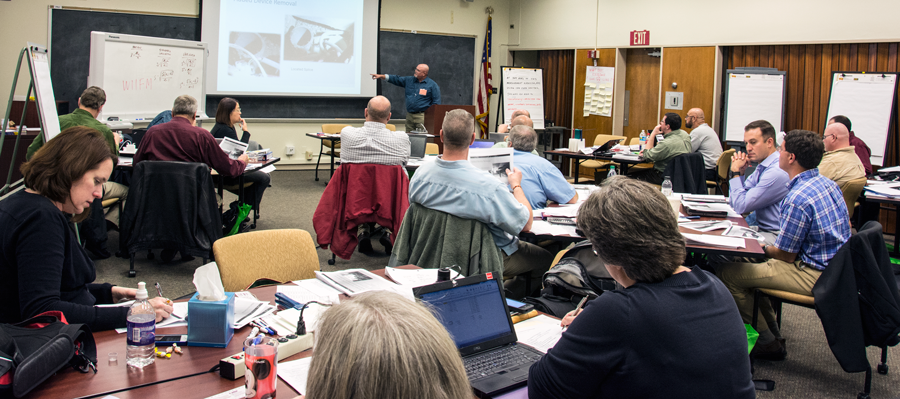OWM Sees Progress in Proficiency Testing

Val Miller demonstrates volume instrument.
Americans rely on many measurements of mass and volume in their daily lives, from weighing broccoli at the grocery store to putting gas in the family car. In order to ensure both consumer confidence and uniformity in commerce, the accuracy of the devices used in those measurements must be tested at regular intervals. The degree of accuracy achieved, in turn, ultimately depends on the competence of the metrologists who calibrate over 350,000 measurement standards per year that are then used by weights and measures officials when testing measuring instruments.
Training and evaluating those personnel is the year-round responsibility of PML's Office of Weights and Measures (OWM), and nationwide the demonstrated abilities of lab staff are trending upward. OWM has just compiled its summary training and proficiency-test data for 2013, which show the highest overall success rate on proficiency testing since the program began collecting data in 2006: 98.97 % now, versus 92.76 % seven years ago.
That improvement is directly tied to OWM's recent efforts. "All persons who work in a standards lab must be able to demonstrate proficiency in order for their labs to be recognized by NIST," says Georgia Harris of OWM's Laboratory Metrology Program. "Each of the 45 or 46 active labs* is recognized with a certificate of measurement traceability to support their state legal requirements; they may also be accredited by NVLAP. When we issue a certificate, the facility, equipment, staff, standards, procedures – the whole system – is examined against international standards. A very big part of that process is training and proficiency testing (PT)."
A big part indeed. In 2013, OWM staff and highly trained volunteer instructors trained 446 students in seminars, 110 students in webinars, and 55 students in workshops for a total of 633 students. In addition, there were 14 proficiency tests conducted in conjunction with several of America's six Regional Measurement Assurance Programs (RMAPs). Proficiency tests averaged 20 participants, each of whom took measurements of 10 different items, for almost 3,700 points of possible pass or failure.
Many factors have contributed to the rising PT success rate. "For one thing, we completely re-designed all our training courses over the past three years," Harris says, "emphasizing adult-learning concepts and ensuring that the training is activity-based and hands-on.** Now when participants come in to our seminar on mass measurement, we issue them a test-weight kit on the first day, and they have to submit comprehensive calibration certificates on their measurements of those artifacts at the end of the two-week course. There's no way to put it off or get more time."

About 20 % to 30 % of PT participants are not from state weights and measures labs. They come from the military, DOE national laboratories such as Sandia and Oak Ridge, and industry. Pharmaceutical companies including Abbott Laboratories and Eli Lilly and Company have sent staff.
Similarly, the training program serves a broad community. OWM conducts training sessions both in the field and at a special educational lab on the NIST Gaithersburg, MD campus. "We have the only training facility of its kind in the world," Harris says. "So we also get people from many other countries, including government and industry metrologists from Canada and Mexico."
Training begins with a course in Fundamentals of Metrology. Passing a math exam is now a prerequisite. "Historically, the biggest challenge with our students has been their math skills," says veteran OWM instructor Val Miller. "Many of our students have been out of school for 10 or 15 years and haven't retained those skills. So we used to spend up to a day of remedial math exercises on simple thing like order of operations."
Another area that typically requires review is correct use of units and symbols. "We spend a lot of time on that," Miller says. "If you give a customer a calibration report with an error on it, it's not simply wrong -- it compromises trust and ruins your credibility. We start emphasizing that at the first session of our Fundamentals course, and keep it up throughout the program. The calibration certificate that goes out has got to be right."
The entire basic course sequence takes four weeks, with two weeks spent on mass. (Ninety percent of all measurements done by state labs involve mass. Volume measurement makes up another 8.5%.) In addition, OWM conducts numerous specialty classes, offers webinars to improve skills and methods, and holds training sessions for trainers.
"At the end of the day, our goal is to assure traceability and uniformity in commerce," says Carol Hockert, chief of OWM. "The only way for us to know whether or not our training is truly successful is by evaluating its implementation. Proficiency tests are an excellent way for us to measure success, so we will continue to improve and expand the use of PTs in our program."
* With the exceptions of Rhode Island, Delaware, and North Dakota each state has a weights and measures lab. The District of Columbia also closed its laboratory about three years ago. However, Los Angeles County, Puerto Rico, U.S. Virgin Islands, and the U.S. Department of Agriculture, Grain Inspection Packers and Stockyards Administration maintain separate lab operations and are participants in the OWM program. "Active" labs are those which participate in the training, regional measurement assurance program training and proficiency testing, and submit requests for laboratory recognition according to NIST Handbook 143, Program Handbook.
** Earlier this year, OWM was named an "authorized provider" by the International Association for Continuing Education and Training, which certifies that the OWM training program is compliant with internationally accepted standards.


